- Our Mission

The Key to Effective Classroom Management
A three-phase process helps build strong teacher-student bonds, which can reduce disruptive behavior.

It’s a daunting but all-too-common sight for many teachers: A classroom full of rowdy students who are unable to focus on the lesson. Classroom management techniques may get things back on track, but valuable time has already been lost.
Many experienced teachers know that making meaningful connections with students is one of the most effective ways to prevent disruptions in the first place, and a new study set out to assess this approach . In classrooms where teachers used a series of techniques centered around establishing, maintaining, and restoring relationships, academic engagement increased by 33 percent and disruptive behavior decreased by 75 percent—making the time students spent in the classroom more worthwhile and productive.
“Strong teacher-student relationships have long been considered a foundational aspect of a positive school experience,” explains Clayton Cook, the lead author of the study and a professor at the University of Minnesota. When those relationships are damaged, student well-being may be affected, leading to academic and behavioral problems.
In the study, teachers used an approach called Establish-Maintain-Restore to build positive interactions with students—a total of 220 in fourth and fifth grade—and boost their sense of belonging. (A follow-up study with middle school teachers used the same strategies, with similar results.) Relationship-building was broken down into three phases: the first meeting, maintenance throughout the school year, and points when a relationship may suffer damage, with useful strategies for each phase.
Since it can be easy for some students to fall through the cracks, a relationship reflection form—like the one we share here—can help teachers take notes on each individual student and highlight ones who need the most attention.
Starting on a Positive Note
At the start of the school year, the teachers in the study made time for establishing relationships. “The goal is to ensure all students feel a sense of belonging that is characterized by trust, connection, and understanding,” Cook and his colleagues explain. For students with learning or behavioral problems, cultivating positive relationships provided “protective effects” that helped them stay focused on learning.
To establish positive relationships, teachers can:
- “Bank time” with students. Schedule one-on-one meetings with students to get to know them better. The goal is to “make deposits into the relationship” to help ease conflict in the future if you have to give constructive feedback or address disruptive behavior.
- Encourage student-led activities. Students feel more invested in their learning if given opportunity to share their interests . Teachers can step aside, be supportive, and listen.
- Welcome students into the classroom. Activities such as positive greetings at the door and icebreaker questions help create a warm classroom culture.
- Use positive communication techniques. Open-ended questions, reflective listening, validation statements, expressions of enthusiasm or interest, and compliments help students—especially shy or introverted ones—ease into classroom discussions.
Maintaining Relationships
Without active maintenance, relationships deteriorate over time, the study authors point out. Teachers may focus too much on academics and not enough on supporting students’ emotional well-being, slowly using up the banked time they initially built up with students.
Teachers can maintain relationships by continuing to implement the strategies above, and in addition they can:
- Take note of positive and negative interactions with students. Teachers should aim for a five-to-one ratio.
- Regularly check in with students. Ask how they’re doing and what support they may need. In an Edutopia article, Todd Finley explains how 5x5 assessment time helped him focus on a handful of students every day.
- Acknowledge good behavior. When teachers focus attention on positive conduct, disruptive behavior is stemmed before it becomes an issue.
Repairing Harm Before Things Get Worse
Eventually, negative interactions such as misunderstandings, conflict, or criticism can weaken a teacher-student relationship. If these negative interactions are left unaddressed, students may feel disengaged and be less willing to participate in activities. They may also be more likely to misbehave, creating further damage. So it’s important for teachers to “intentionally reconnect” with students to restore the relationship to a positive state.
When relationships need repair, teachers can:
- Let go and start fresh. Teachers should avoid holding mistakes over a student’s head, instead giving them a chance to start each day with a clean slate.
- Take responsibility for their actions. Teachers can avoid blaming students when things go wrong, and think, “What could I have done to avoid the problem in the first place?” They shouldn’t be afraid to apologize when that’s called for—doing so helps build trust with students.
- Show empathy. There are two sides to every story, and a teacher can acknowledge that students may have a different perspective about what happened.
- Focus on solutions, not problems. Teachers can work with students to find a solution that everyone feels is fair.
- Separate the deed from the doer. It’s important to criticize the behavior, not the person. If teachers label children as “problem students,” there’s a danger that they’ll internalize that label, making it more likely that they’ll repeat the behavior in the future.
The takeaway: Effective classroom management starts with relationship building. When students feel a greater sense of belonging, they’re more likely to be academically engaged and demonstrate positive behavior.
- NAEYC Login
- Member Profile
- Hello Community
- Accreditation Portal
- Online Learning
- Online Store
Popular Searches: DAP ; Coping with COVID-19 ; E-books ; Anti-Bias Education ; Online Store
Guidance and Challenging Behaviors
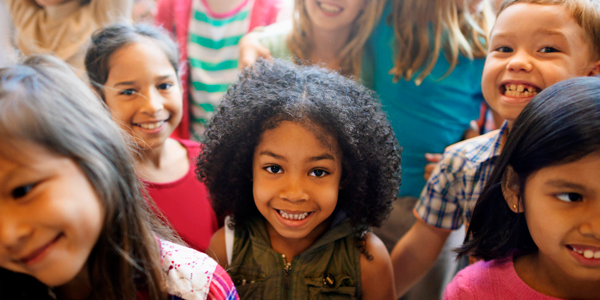
You are here
Guiding children.
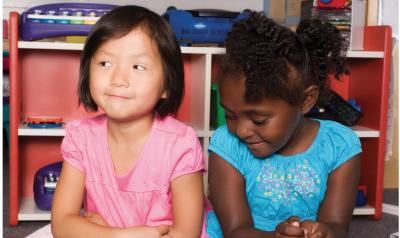
Culturally Appropriate Positive Guidance with Young Children
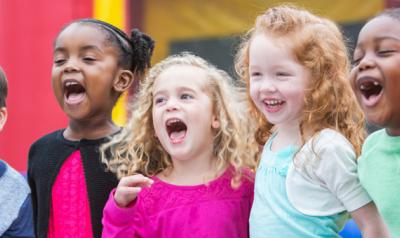
Standing Together Against Suspension and Expulsion in Early Childhood Education

Standing Together Against Suspension & Expulsion in Early Childhood: Resources

Planning for Positive Guidance: Powerful Interactions Make a Difference
Encouraging positive behavior.

Building Environments That Encourage Positive Behavior: The Preschool Behavior Support Self-Assessment
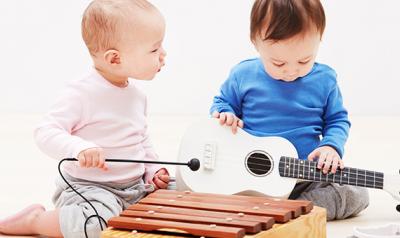
Rocking and Rolling—It Takes Two: The Role of Co-Regulation in Building Self-Regulation Skills
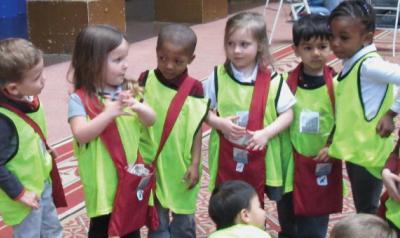
Bullying in Early Childhood

To Prevent Bullying, Focus on Early Childhood
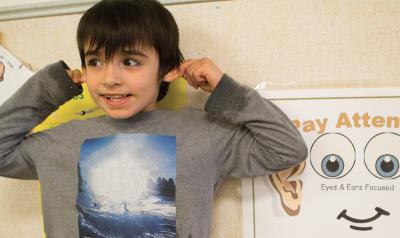
Focusing on Families: A Two-Generation Model for Reducing Parents’ Stress and Boosting Preschoolers’ Self-Regulation and Attention
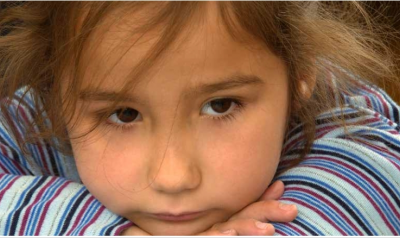
Creating Trauma-Sensitive Classrooms
To share with families.
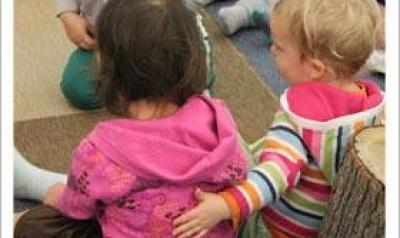
10 Tips for Raising a Compassionate Infant-Toddler

Observation: The Key to Understanding Your Child

Understanding and Responding to Children Who Bite

The Not-So-Magic Word

Message in a Backpack™ Guiding Your Child’s Behavior
Most recent, spotlight on young children: challenging behavior, authored by.

Functional Assessment and Positive Behavior Support: The Role of Early Learning Program Leaders and Teachers

A Three-Step Approach: Promoting Young Children’s Self-Regulation and Language During Conflict

Tearing Down Silos: A Model for Interagency Collaboration

Instead of Discipline, Use Guidance
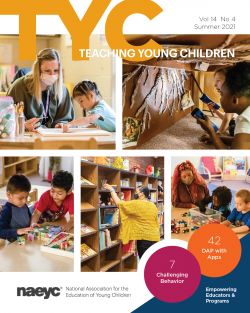
Summer 2021

A Road Forward: Five Democratic Life Skills for a Civil Society

NAEYC Publishes New Book on Addressing Challenging Behavior in Young Children

Becoming a Better Behavior Detective: Applying a Developmental and Contextual Lens on Behavior to Promote Social and Emotional Development

Rocking and Rolling—It Takes Two: The Role of Co-Regulation in Building Self-Regulation Skillsالتناغم والتآزر - يد واحدة لا تص فِّق: دور التنظيم المشترك في بناء مهارات التنظيم الذاتي عند الطفل
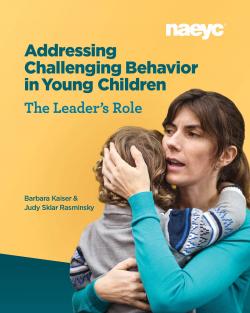
Addressing Challenging Behavior in Young Children: The Leader's Role
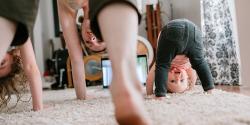
Message in a Backpack™ Helping Your Child through Change

Supporting Anxious Children in the Preschool Classroom

Partnering with Families Supporting Social and Emotional Development through Picture Books
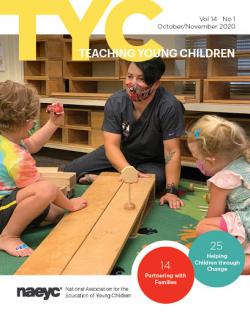
October/November 2020

التفاهم مع الأطفال الذين يمارسون سلوك العض وطريقة الاستجابة لهم Understanding and Responding to Children Who Bite

“How Can I Help You?”: Reconsidering Behavior Management
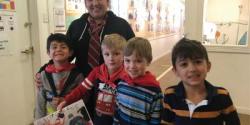
انظر واسمع وتعلم: اللطف في المعاملة Look, Listen, Learn: The Kindness Movement

Ask Hello. How to Handle Hurtful Words

Responding to Behavioral Challenges in the Classroom
Working to maintain safe and productive schools..
Posted December 14, 2021 | Reviewed by Ekua Hagan
- A recent survey shows behavioral issues in schools are on the rise.
- Increased class size, pandemic-related stressors, and mental health issues are common causes for behavioral issues.
- The inclusion of special needs students in general classrooms is creating new challenges for teachers.
- Taking immediate action and focusing on de-escalation are key ways to manage disruptions in the classroom.
Teachers and educators across the country are having to deal with more behavioral challenges in the classroom than ever before, all of which cause a variety of obstacles toward creating and maintaining safe and productive learning environments.
In a recent survey by the Education Advisory Board (EAB), 81% of school administrators indicated the frequency of disruptive behaviors in their schools is either “more” or “significantly more” than during the previous three years. Seventy-one percent of teachers responded the same, also estimating they lose an average of 144 minutes of instructional time per week (14.5 school days per year) due to behavioral disruptions in the classroom.
Reasons for behavioral challenges
There are many factors that can lead to behavioral challenges in the classroom, including increased class size and staffing issues, the inclusion of special needs students in general classrooms, pandemic-related stressors, and an increase in mental health issues driven by conditions in the home such as food and housing insecurities, parent-related problems, and financial difficulties.
No two behavioral challenges are the same in their cause or manifestation. One may be a result of a learning disability or autism and another of lack of sleep or a divorce . One child may express their frustration by acting out and another by remaining unresponsive. All of this leaves school districts, and teachers, with countless behavioral challenges to navigate while at the same time trying to state-mandated teaching curricula and keep students safe.

A common factor among many students exhibiting behavioral challenges is an inability to communicate effectively. This frustration can escalate quickly and cause significant disruption to a classroom. Reasons for a student’s difficulty in expressing themselves can range from autism or neurological disorders to issues in the home or fear of being mocked by peers. Related to this is a student feeling misunderstood, which can very easily turn into a volcano-waiting-to-erupt situation. Communication and self-expression are fundamental human needs; not being able to meet those needs, or feeling uncomfortable doing so, can create an enormous pressure and preclude a student from being able to learn and cooperate–particularly in a classroom setting where communication is generally controlled and moderated by an instructor.
Understanding and assessing factors
Probably the biggest mistake made in schools when it comes to mitigating behavioral challenges is educators waiting for a situation to escalate before acting. Today’s small problem is tomorrow’s major issue. It is essential for educators to identify specific indicators of impending behavior problems before they escalate into full-scale outbursts that can bring classroom activity to a screeching halt. Offering support, teaching alternative behaviors, and allowing more time or a break from the activity when the student is engaged in disruptive behaviors—like tapping a pen—are likely to prevent situations from escalating.
While there are many different types of behavioral challenges that can arise in the classroom, there are a few that are commonplace and indicative of a child struggling with either a physical, mental, or emotional issue. Complete withdrawal is something most teachers must contend with at one point or another. The student may put their head down on the desk, close their eyes, pull their hood over their head and just shut off. The student may also ignore the teacher’s requests to pay attention and refuse to engage in conversation. Occasionally, the student may just get up and walk out of the classroom.
Another common behavioral challenge is making some sort of distracting noise, such as pen-tapping, knocking on the desk, talking out, or making noises with their mouth. When outbursts occur, common physical behavioral challenges include hitting, punching, kicking, biting, pushing, throwing objects and even self-injurious actions such as cutting , or self-hitting.
Tips for managing behavioral challenges
School districts must provide teachers with the necessary tools and training to handle behavioral challenges in the classroom. Oftentimes this does not happen due to budget cuts, limited staff, and time constraints. There are some basic strategies and approaches teachers can easily implement. Here are a few practical tips and insights for teachers and educators to better understand and manage behavioral challenges in the classroom:
- Remember your first goal is to de-escalate the situation. Pick your battles. If a student is disrupting the classroom in a major way, it’s not necessarily the right moment to reprimand the student. Do what you need to do to calm the situation and handle the other issues privately and when tensions are not high.
- Acknowledge good behavior. Look for opportunities to praise students who have presented behavioral challenges when they are following expectations and participating appropriately. It’s important they hear from you not only when they do something wrong but when they do something right. We may forget to focus on the students’ appropriate behavior. Every student does something right every day. Capture those moments, too.
- Give the student an alternative to their challenging behavior. Don’t just tell the student to “stop,” but rather suggest an acceptable alternative. If the student is banging on the desk with a pen, suggest they take out a piece of paper and draw to keep their hands busy.
- Reset the situation. Rather than engage in an unproductive back-and-forth with a student, ask the student if they would like to step outside for five minutes and take a breath of fresh air. A pause can be an extremely effective tactic in getting back on track.
- Ask for help. Don’t be reluctant to use all the resources available at your school. Connect with other teachers, counselors, and administrators even if only to brainstorm ideas. Perhaps ask a colleague to observe your classroom and give a second opinion.
- Understand school is only one part of a child’s life. Many behavioral challenges in the classroom are driven by issues that have nothing to do with school. As appropriate, work with school counselors and administrators to assist the student with his or her life challenges.
- Pay attention to your behavior. Remember your behavior (tone and volume of your voice, facial expression, body posture, proximity, etc.), have a significant impact on a situation. It is easy to forget how triggering a disapproving look or raised voice can exacerbate an already contentious interaction. Make sure you are not unintentionally making a bad situation worse.
- Make sure your response is commensurate with what is happening that moment. It is easy to overreact to a specific situation based on previous history. Make sure there are no straws that break the camel’s back.

Maria Ferlick is a licensed teacher certified in Intensive Special Needs Education, as well as a Board Certified Behavior Analyst and a Licensed Applied Behavior Analyst and a Master Trainer with QBS, provider of the Safety-Care behavior management and crisis prevention training program.
- Find a Therapist
- Find a Treatment Center
- Find a Psychiatrist
- Find a Support Group
- Find Teletherapy
- United States
- Brooklyn, NY
- Chicago, IL
- Houston, TX
- Los Angeles, CA
- New York, NY
- Portland, OR
- San Diego, CA
- San Francisco, CA
- Seattle, WA
- Washington, DC
- Asperger's
- Bipolar Disorder
- Chronic Pain
- Eating Disorders
- Passive Aggression
- Personality
- Goal Setting
- Positive Psychology
- Stopping Smoking
- Low Sexual Desire
- Relationships
- Child Development
- Therapy Center NEW
- Diagnosis Dictionary
- Types of Therapy

Understanding what emotional intelligence looks like and the steps needed to improve it could light a path to a more emotionally adept world.
- Coronavirus Disease 2019
- Affective Forecasting
- Neuroscience
Student misbehaviour is consistently regarded as one of the biggest concerns and challenges for PE teachers, especially trainees and NQTs. Fortunately we are not alone, as schools and educators from around the world have shared their struggles and noted how poor behaviour significantly impairs class progress.
Pupil misbehaviour distracts both teachers and pupils from a learning focus, which has resulted in teachers having to spend more time on behaviour management rather than student learning. In 1979, Sieber estimated the average teacher reacts to behaviour problems approximately 87 times a day, or 16,000 times a year, which is likely similar in today’s schools or potentially worse. Subsequently, the challenge of managing behaviour has been described as the “most distressing aspect of the profession” (Gal, 2006, p.377), and contributes to teacher dissatisfaction, stress, burnout, and early retirement from the profession. As a result, it has been suggested that many heads of schools tend to employ teachers predominantly on their ability to manage behavioural problems. Therefore, it is invaluable for physical educators to clarify the different classifications of misbehaviour and to have a repertoire of behaviour management tools [ 1-6 ].
In schools, teachers have been expected to encounter a wide range of misbehaviours, which are largely similar for both classroom and physical education lessons. The most troublesome and frequently occurring misbehaviours are relatively mild but repetitive disturbances which have a disruptive influence on the class, these include talking , distracting others , and late arrival . Whereas, the more severe disturbances are less common but equally important, “as even one case of these types of incidents is one too many” (Krech et al, 2010). These include aggressive behaviour , bullying and dangerous conduct , which may be harder to detect as they are likely to be shielded by pupils. In PE lessons, the reported misbehaviour of pupils is largely similar, but possesses a slightly more extensive list due to the physical nature of the subject [ 6-10 ]. For the purpose of clarity, students’ misbehaviours in general lessons and physical education were compiled from literature to produce a diagram, ranging from mild to severe disturbances [see Figure 1].
For dealing with these misbehaviours, a range of models and standard techniques can be found in behaviour management texts, which encourage proactive planning , excellent management skills , and positive interpersonal relationships . Proactive planning requires teachers to provide pupils with structured lessons, which begins with the establishment of clear expectations, rules and routines, followed by the production and implementation of well-planned and well-presented lessons which are individualised to the needs and interests of the students. In research by educators, pupils’ academic achievement and attitude has been linked with the establishment of clear expectations, rules and routines by teachers at the beginning of the school year. Thus, teachers are recommended to clearly state their expectations for students during the first few lessons of the year, clarifying any possible misunderstandings, and the consequences of misbehaviour [ 5-12 ].
There are many ways to go about establishing expectations for your class. However, a very simple set of expectations that encompass all types of behaviour, are:
- Respect for others and equipment
- Listen carefully to instructions and follow them quickly
- Try your best at all times
This should be one of the first things to go through with your classes at the beginning of the very first lesson, and should be revisited throughout the school year as needed (particularly after an extended break or with younger students).
In addition, the development of rules and routines during the initial lessons will provide students with consistent expectations for how your PE lessons will start and finish, from lining up, getting changed and the procedures for handling and storing equipment, which all contribute greatly to class control [ 5 , 7 , 12 ].
Good management skills (in combination with proactive planning) has been identified as an effective approach for handling primary misbehaviours of a repetitive nature, and is composed of non-verbal and verbal cues. Non-verbal cues are a non-intrusive, non-confrontational strategy which has been highlighted as an essential management tool for teachers to possess, as it is unlikely to cause any negative effects. Examples of non-verbal cues includes the use of physical proximity, maintaining eye contact, the teacher stare, waiting for silence, hand signals, and body language [ 6 , 13-15 ].
Physical proximity involves the teacher moving into the misbehaving students’ area to convey the message that their inappropriate behaviour has been noticed. Whilst, maintaining eye contact and the teacher stare can halt misbehaviour as they illustrate to pupils the teacher’s awareness and control without disturbing the learning environment. When talking to the whole-class, it is essential to wait for silence before addressing your students, this has been acknowledged as an easily achievable non-verbal control technique , which is complimented by the use of hand signals (e.g., a finger to the lips to signal silence or a raised hand) or body language (e.g., folded arms to signal waiting and expectancy). Therefore, non-verbal cues have been recognised as subtle yet effective techniques to manage primary misbehaviours, which can help minimise noise in your lessons and reduce teacher stress [ 5 , 12 , 14 , 15 ].
Despite the use of non-verbal cues, sometimes the simplest and most efficient approach to managing pupil misbehaviour is by asking the offending pupils to stop ; this has been referred to as verbal cueing . In literature, the general consensus and guidelines for verbal cues suggests teachers remain calm and polite for all disturbances , using a positive approach to frame their correction and direction. This could be achieved by privately talking to the pupil(s) about how their behaviour was unacceptable, its impact on others, and then offering a positive alternative by clarifying the appropriate behaviour and promoting the task. Alternatively, you could start by asking pupils why they’ve been stopped and spoken to, and for them to reflect on their behaviour and if it matches the classes’ expectations.
If the situation continues and requires the pupil to be reprimanded, teachers have been recommended to depersonalise sanctions, by rejecting the behaviour, not the student, and highlighting that continued misbehaviour will force the teacher to issue a sanction whilst emphasising the pupils autonomy e.g., "If you choose to continue to behave in this way..." [ 5 , 9 , 12 ].
In order to maintain and develop positive interpersonal relationships with students, teachers need to be firm , consistent , and fair , demonstrating that they care about both pupil’s work and their lives inside and outside of school. This requires teachers to be accepting , confident , caring , relaxed , in control , professional , humorous , in charge of the class , inspiring , encouraging , and passionate about their subject . If teachers adopt these characteristics, use good management skills and proactively plan their lessons a foundation of control and discipline will be established in lessons. If forced to sanction a student, literature strongly opposes the use of coercive and aggressive disciplinary strategies , such as shouting , threats , exercise as punishment , criticism and sarcasm , as they have been reported to diminish a sense of responsibility , distracts pupils from learning, damages self-esteem , and can cause escalation of misbehaviour [ 5 , 13 , 16-18 ].
With regards to sanctioning pupils, the aforementioned micro-level strategies (non-verbal and verbal cues) are the most effective for handling primary and some secondary misbehaviours. Whilst more severe and aggressive behaviours would require macro-level guidance via the school’s behaviour policy [ 6 , 12 ]. All schools are different in this area with some still permitting the use of detentions, whether during break or after school, which should be administered on the same day. Whilst others prefer a more relational approach such as restorative justice meetings where the pupil(s) involved discuss the situation in more detail in an effort to resolve the issue and prevent reoffending. This should be overseen by the Head of Department or by a member of senior management. Other strategies include phone calls home and meetings with parents to discuss their child’s behaviour and to establish a behavioural improvement plan.
When rewarding pupils, it is also advised to follow your school’s/department’s policy. However, one of the most effective forms of reward in a school has been recognised as positive comments. Which is important for fostering positive interpersonal relationships, raising pupils’ self-esteem, and reducing off-task behaviour, which includes recognising good behaviour, praising high standards of work and appropriate attitudes [ 12 , 13 , 17 , 18 ). The best use of extrinsic rewards have been described as informational , which generally consists of the teacher providing specific and private feedback about a student’s competence at a certain task [ 18-19 ]. Other meaningful methods of rewards include e-mails or phone calls home to share student’s accomplishments, which help build a positive rapport with both pupils and parents.
If you don’t know your school’s and/or department’s policy for rewards and sanctions, make sure you grab a copy, highlight the key bits of information and pin them above your desk as a constant reminder.
Once you are familiar with your school’s behaviour policy, it is beneficial to use the Classifications of Misbehaviour (Figure 1) to establish a clear hierarchy of sanctions that are in adherence with your school’s policies and literature. For example, for initial primary misbehaviours (mild disturbances) the first step could be a non-verbal cue, the second step, an anonymous verbal cue i.e., “Still waiting on one more person!”, the third, a private verbal cue which would consist of talking quietly, yet firmly to the student about the behaviour you expect from them (you could even tell them that this is their first verbal warning). If their misbehaviour continues then decide on your next steps, maybe asking them to work with another group or alone, or to sit out for few minutes. If a student continues to choose not to follow the rules, then they have had ample opportunities to adjust their behaviour and it is now the time to use the next sanction. In your school this may be a break-time or after-school detention or a meeting with the head of department etc. Again, it is vital that you operate under the school’s behaviour management policy.
With regards to more severe misbehaviour (i.e., secondary) you will most likely jump straight to a verbal cue (first warning) or for tertiary misbehaviour a sanction such as a detention, or even being excluded from the class or being collected by a member of senior management may be best.
As a result of this literature review, the key points for effective behaviour management can be deduced to the following steps:
- Classifications of misbehaviour (primary, secondary and tertiary)
- Proactive planning (clear expectations, rules and routines, structured lessons)
- Excellent management skills (non-verbal and verbal cues)
- Positive Interpersonal Relationships (teacher characteristics)
- Rewards (specific and private feedback)
- Clear hierarchy of sanctions (in alignment with school behaviour policy)
As physical educators if we have an understanding of these aforementioned principles and actively make strides in developing our own classifications, hierarchy of sanctions, routines, lesson planning and personal skills which are tailored to our school’s ethos and policy documents then we will have laid a strong foundation of high expectations for our PE lessons. This can then be bolstered by reading up on different behaviour management strategies, reflecting and sharing best practice with colleagues and even help in the development of the school’s behaviour policy which should be a living, breathing document.
Rogers, S. (2019) 'Behaviour Management in Physical Education', Physical Education Matters, Spring (2019), pp. 31-33.
- Vogler, E.W. and Bishop, P. (1990) ‘Management of disruptive behaviour in physical education’ Physical Educator. 47, pp. 16-26.
- Kulinna, P.H., Cothran, D. and Regualos, R. (2003) ‘Development of an Instrument to Measure Student Disruptive Behaviour’ Measurement in Physical Education and Exercise Science. 7(1), pp. 25-41.
- Sieber, R. T. (1979) ‘Classmates as workmates: Informal peer activity in the elementary school’.
- Gal, N. (2006) ‘The role of Practicum supervisors in behaviour management education’ Teaching and Teacher Education. 22, pp. 377-393. Attendance Policy. London: DfE.
- Bailey, R. (2001) ‘Managing Behaviour’, In Teaching Physical Education: A Handbook for Primary & Secondary School Teachers. London: Kogan Page. pp. 99-116.
- Krech, P.R., Kulinna, P.H. and Cothran, D. (2010) ‘Development of a short-form version of the Physical Education Classroom Instrument: measuring secondary pupils’ disruptive behaviours’ Physical Education and Sport Pedagogy. 15(3), pp. 209-225.
- McCormack, A. (1997) ‘Classroom Management Problems, Strategies and Influences in Physical Education’ European Physical Education Review. 3(2), pp. 102-115.
- Houghton, S., Wheldall, K. and Merrett, F. (1988) ‘Classroom Behaviour Problems which Secondary School Teachers say they find most troublesome’ British Educational Research Journal. 14(3), 297-312.
- Lewis, R. (1999) ‘Teachers’ support for inclusive forms of classroom management’ International Journal of Inclusive Education. 3(3), pp. 269-285.
- Garner, P. (2009) ‘Behaviour for Learning: A positive approach to classroom management’ In Capel, S., Leask, M. and Turner, T. (eds.) Learning to Teach in the Secondary School: A Companion to School Experience. 5th edn. London: Routledge. pp. 138-154.
- Haroun, R. and O’Hanlon, C. (1997) ‘Do Teachers and Students Agree in their Perception of What School Discipline Is?’ Educational Review. 49(3), pp. 237-250.
- Cowley, S. (2003) Getting the Buggers to Behave 2. London: Continuum.
- Ellis, S. and Todd, J. (2009) Behaviour for Learning: Proactive approaches to behaviour management. Oxon: Routledge.
- Rink, J.E. (2006) Teaching Physical Education for Learning. 5th Edn. London: McGraw Hill.
- Atici, M. (2010) ‘A small-scale study on student teachers’ perceptions of classroom management and methods for dealing with misbehaviour’ Emotional and Behavioural Difficulties. 12(1), pp. 15-27.
- Department of Education and Science (DES) (1989) ‘Discipline in Schools: Report of the Committee of Enquiry Chaired by Lord Elton’ The Elton Report. London: HMSO
- Smith, R. (1995) Develop your classroom management skills. Lancaster: Framework Press Educational Publishers Ltd. pp. 1-18.
- Morgan, K., Milton, D., and Longville J. (2015) Motivating pupils for learning in PE. In Capel, S. & Whitehead, M (Ed) Learning to Teach Physical Education in the Secondary School: A Companion to School Experience. 4th Edition. London: Routledge.
- Deci, E.L. and Ryan, R.M. (1985) Intrinsic Motivation and Self Determination in Human Behaviour. New York: Plenum Press.

Earth Day 2024: ‘Green muscle memory’ and climate education promote behaviour change
Fellow, Dalla Lana Journalism and Health Impact, University of Toronto
Disclosure statement
Preety Sharma is a public health and development consultant. As a freelance journalist, she covers climate change, public health and nutrition.
Ayeshah Haque is a Clinical Content Specialist at the Association for Ontario Midwives.
University of Toronto provides funding as a founding partner of The Conversation CA.
University of Toronto provides funding as a member of The Conversation CA-FR.
View all partners
This year, organizers of Earth Day are calling for widespread climate education as a critical step in the fight against climate change.
A new report , released in time for global attention for Earth Day on April 22, highlights the impact of climate education on promoting behaviour change in the next generation.
Despite people’s deep connection to their local environment — whether it’s blackouts in Toronto caused by raccoons , communities gearing up for a total solar eclipse lasting only minutes, chasing northern lights or hundreds of Manitoba kids excited about ice fishing — there remains inertia in climate action.
Sparking global momentum and energy in young people can go a long way to addressing climate change now and in the near future, says Bryce Coon, author of the report and Earth Day’s director of education.
How knowledge becomes ingrained
Educators aspire to prepare learners for the global challenges of the times. Teachers have become increasingly concerned about best practices for supporting their charges as young people express anxiety about environmental futures.
In his report, Coon outlines the benefits of climate education, starting with supporting educators to impart “green muscle memory” — habits, routines and attitudes young people develop to perform eco-friendly actions repetitively and consistently. This, he notes, contributes to alleviating climate-related despair and anxiety.

Similarly, Finnish researchers use biking as an analogy to describe the process by which knowledge becomes ingrained in people’s memory. Just as all of the parts of a bike need to work together for the bike to ride smoothly, so does climate education need to draw upon many different components for climate education to effectively influence new habits. The bike model advocates ways of learning that consider knowledge, identity, emotions and world views.
Young people have come to flex their green muscle memory when they load reusable water bottles each day. That small action has become a part of the daily routine for millions of families, and when added together reduces plastic litter.
According to a 2022 survey by the Canadian charity Learning for a Sustainable Future (LSF) and Leger Research Intelligence Group, Canadians have increased awareness of climate change and have become concerned about climate action.
Many believe governments should do more, including making climate education a priority. The survey received responses from 4,035 people including educators, students and parents. More than half of the survey respondents were from Ontario (25 per cent) and Québec (29 per cent).
Challenges with climate education
However, inclusion of climate education in formal school curricula has come with its own set of challenges.
In the survey, 50 per cent of educators nationally agreed that a lack of time in their course or grade to teach the topic of climate change is a barrier. Educators in Ontario reported a lack of classroom resources as a barrier when integrating climate change education within the curriculum.
Read more: 6 actions school systems can take to support children's outdoor learning
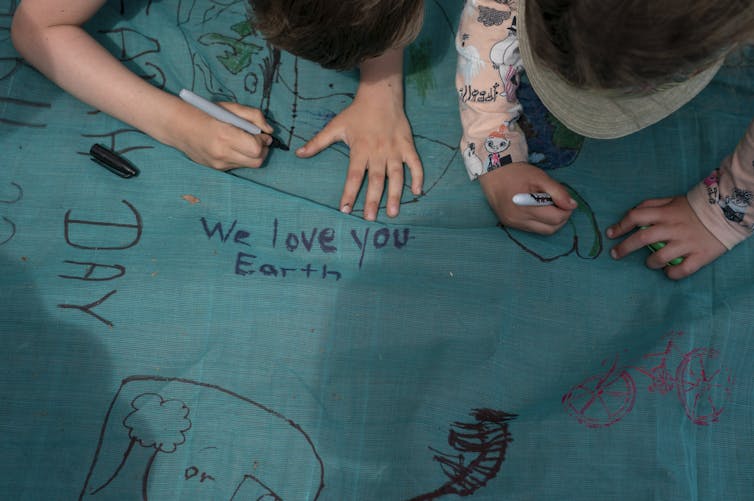
Evidence is building about the benefits of implementing and expanding climate education. A 2020 American study documented how students enrolled in a year-long university environmental education course reported pro-environmental behaviours after completing the course.
Extrapolating the impact on learners to a wider scale, the researchers argued scaling climate education had the potential to be as effective as other large-scale mitigation strategies for reducing carbon emission, like solar panels or electric vehicles.
More recently, research has demonstrated the value of how learning in climate education can lead youth to seek green choices, take green action and make green decisions. The United Nations has declared climate education “a critical agent in addressing the issue of climate change ” as climate education increases across different settings and for various age groups.
Educators finding ways
More and more educators are taking steps to find ways to teach climate education in schools. Emily Olsen, an educator and now a doctoral candidate at Penn State University, began to explore climate education in greater depth after surviving the Almeda wildfire in Oregon that claimed her fiancé’s family home.
This wildfire’s severity can most likely be attributed to drier-than-normal conditions brought on by climate change in her then-town of residence.
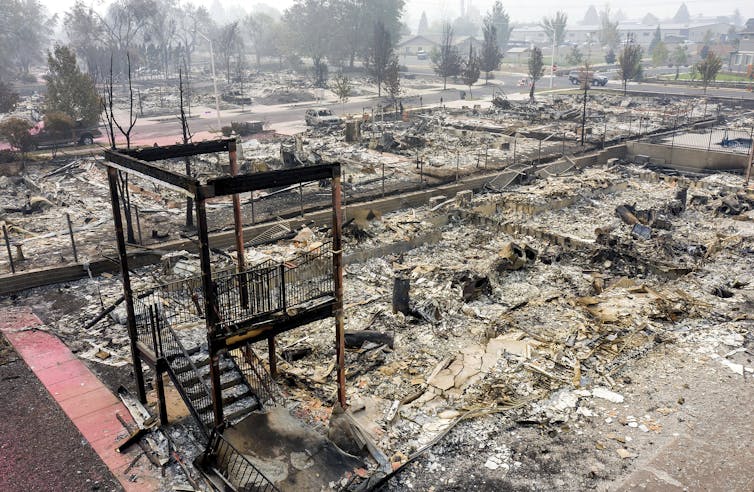
Due to Olsen’s lived experience, developing community resilience to the effects of climate change influences her approach to studying climate education. As an instructor for several undergraduate-level courses, Olsen focuses on equipping budding educators with the skills and knowledge to incorporate climate education in their classrooms.
Read more: Wildfires in Alberta spark urgent school discussions about terrors of global climate futures
All aspects of curricula
Embedding climate education into all aspects of curricula can take a variety of approaches in and outside of the classroom .
In mainstream public education, climate education is becoming more common in Canada, but there is variation across provinces and territories. Environmental education has been packaged in different forms , including broadening school curricula with inclusion in science, but also subjects including English, math and art.
Teacher training as well as complementary programming is also being offered to meet demand.
Integrated education that taps into the “heart, head and hands” of young people can spread behaviour change at a broader level. Educators might find other opportunities, such as with climate-related challenges, experiential learning and project-based learning, all of which can have lasting impacts and promote behaviour change.
- Climate change
- Climate change education
- Muscle memory
- Environmental education

Project Offier - Diversity & Inclusion

Senior Lecturer - Earth System Science

Sydney Horizon Educators (Identified)

Deputy Social Media Producer

Associate Professor, Occupational Therapy
Numbers, Facts and Trends Shaping Your World
Read our research on:
Full Topic List
Regions & Countries
- Publications
- Our Methods
- Short Reads
- Tools & Resources
Read Our Research On:
Changing Partisan Coalitions in a Politically Divided Nation
2. partisanship by race, ethnicity and education, table of contents.
- What this report tells us – and what it doesn’t
- Partisans and partisan leaners in the U.S. electorate
- Party identification and ideology
- Education and partisanship
- Education, race and partisanship
- Partisanship by race and gender
- Partisanship across educational and gender groups by race and ethnicity
- Gender and partisanship
- Parents are more Republican than voters without children
- Partisanship among men and women within age groups
- Race, age and partisanship
- The partisanship of generational cohorts
- Religion, race and ethnicity, and partisanship
- Party identification among atheists, agnostics and ‘nothing in particular’
- Partisanship and religious service attendance
- Partisanship by income groups
- The relationship between income and partisanship differs by education
- Union members remain more Democratic than Republican
- Homeowners are more Republican than renters
- Partisanship of military veterans
- Demographic differences in partisanship by community type
- Race and ethnicity
- Age and the U.S. electorate
- Education by race and ethnicity
- Religious affiliation
- Ideological composition of voters
- Acknowledgments
- Overview of survey methodologies
- The 2023 American Trends Panel profile survey methodology
- Measuring party identification across survey modes
- Adjusting telephone survey trends
- Appendix B: Religious category definitions
- Appendix C: Age cohort definitions
As has long been the case, White voters are much more likely than those in other racial and ethnic groups to associate with the Republican Party. Hispanic and Asian voters tilt more Democratic. Black voters remain overwhelmingly Democratic.
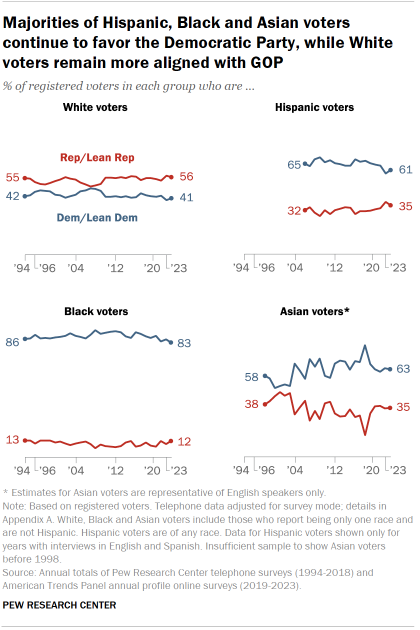
However, there have been some shifts toward the GOP in most groups in recent years.
The Republican Party now holds a 15 percentage point advantage among White voters: 56% of non-Hispanic White voters identify with or lean toward the Republican Party, while 41% align with the Democratic Party.
- This double-digit lead for the GOP among White voters has held for more than a decade. The last time White voters were about equally split between the two parties was in 2008.
About six-in-ten Hispanic voters (61%) are Democrats or lean to the Democratic Party, while 35% are Republicans or Republican leaners.
- The Democratic Party’s edge among Hispanic voters over the last two years is somewhat narrower than it was in years prior.
Black voters continue to overwhelmingly associate with the Democratic Party, although the extent of the Democratic advantage among this group has fallen off over the last few years.
- Currently, 83% of Black voters are Democrats or lean Democratic, while 12% align with the GOP.
- As recently as 2020, the share associating with the Democratic Party was 5 percentage points higher. That somewhat larger edge in party affiliation had been in place for much of the last two decades.
About six-in-ten Asian voters (63%) align with the Democratic Party, while 36% are oriented toward the GOP.
- The balance of partisan association among Asian voters has changed little over the last few years.
The relationship between education and partisanship has shifted significantly since the early years of the 21st century.
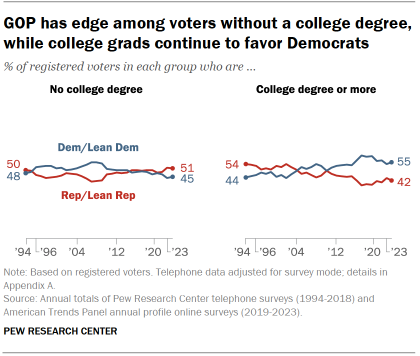
- The Republican Party now holds a 6 percentage point advantage over the Democratic Party (51% to 45%) among voters who do not have a bachelor’s degree. Voters who do not have a four-year degree make up a 60% majority of all registered voters.
- By comparison, the Democratic Party has a 13-point advantage (55% vs. 42%) among those with a bachelor’s degree or more formal education.
This pattern is relatively recent. In fact, until about two decades ago the Republican Party fared better among college graduates and worse among those without a college degree.
In the last years of George W. Bush’s presidency and the first year of Barack Obama’s, Democrats had a double-digit advantage in affiliation over Republicans among voters without a college degree. For example, in 2007, 56% of voters without a degree were Democrats or leaned Democratic, while 42% were Republicans or GOP leaners. This group was narrowly divided between the two parties for most of the next 15 years, but in the last few years it has tilted more Republican.
College graduates moved in the opposite direction, becoming more Democratic over this same period.
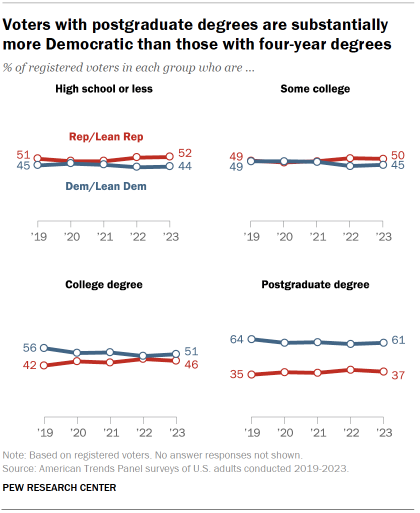
- Since 2017, the gap in partisanship between college graduates and those without a degree has been wider than at any previous point in Pew Research Center surveys dating back to the 1990s.
Voters with postgraduate degrees are even more Democratic than those with bachelor’s degrees. About six-in-ten registered voters who have a postgraduate degree (61%) identify with or lean toward the Democratic Party, while 37% associate with the Republican Party. Voters with a bachelor’s degree but no graduate degree are more closely divided: 51% Democratic, 46% Republican.
Voters with a high school degree or less education and those who have attended some college but do not have a bachelor’s degree both tilt Republican by similar margins.
White voters are far more polarized along educational lines than are Hispanic and Black voters.
White voters by education
By nearly two-to-one (63% vs. 33%), White voters without a bachelor’s degree associate with the Republican Party.
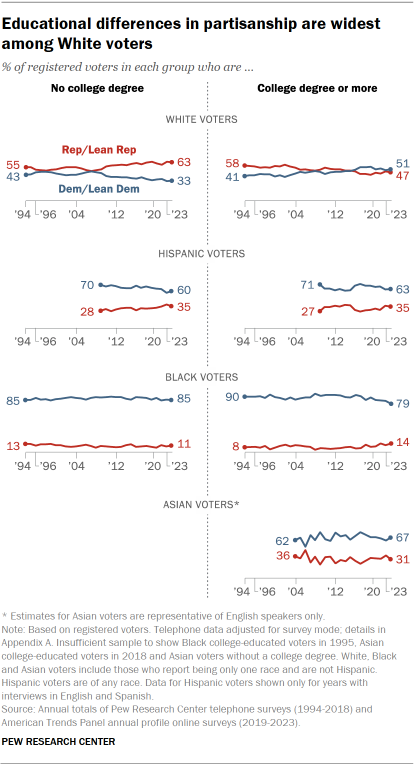
The GOP’s advantage among this group has remained relatively steady over the last several years but reflects a major shift since 2009. This group is now substantially more Republican-oriented than at any prior point in the last three decades.
Today, White voters with a bachelor’s degree are closely divided between associating with the Democratic Party (51%) and the Republican Party (47%). Prior to 2005, this group had a clear Republican orientation.
Hispanic voters by education
In contrast, there are no meaningful differences in the partisan leanings of Hispanic voters with and without bachelor’s degrees. Democrats hold a clear advantage in affiliation among both groups of Hispanic voters, although the share of Hispanics (both those with and without bachelor’s degrees) who align with the Democratic Party has edged lower in recent years.
Black voters by education
Black voters both with (79%) and without college degrees (85%) remain overwhelmingly Democratic in their partisan affinity.
Black college graduates are somewhat less closely aligned with the Democratic Party now than they were for most of the prior three decades (for most of this period, 85% or more of Black college graduate voters affiliated with the Democratic Party).
Asian voters by education
Two-thirds of Asian voters with a college degree align with the Democratic Party; 31% associate with the Republican Party. The partisan balance among Asian voters with a college degree has remained largely the same over our last two decades of surveys. (Asian American voters without a college degree are a smaller group, and sample sizes do not allow for reporting trends among this group.)
Visit the chapter on partisanship by gender, sexual orientation and marital and parental status for discussion of overall trends among men and women.
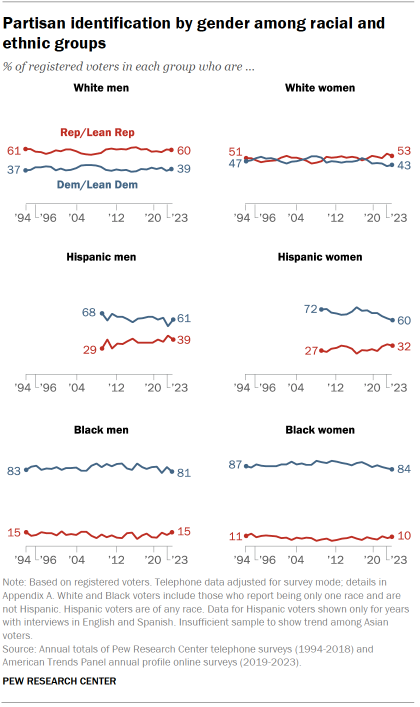
Six-in-ten White men who are registered voters identify as Republicans or lean Republican, as do 53% of White women voters.
The balance of partisanship among White women voters has tilted toward the GOP in recent years, but it was more divided in 2017 and 2018.
Among Hispanic voters, about six-in-ten men (61%) and women (60%) associate with the Democrats. Hispanic women voters have become somewhat less Democratic in recent years (down from 74% in 2016).
About eight-in-ten Black voters – both women (84%) and men (81%) – are Democrats or Democratic leaners.
About six-in-ten men (61%) and women (64%) among Asian voters identify as Democrats or lean toward the Democratic Party. (There is insufficient sample to show longer-term trends among Asian voters by gender.)
Among White voters, there are wide differences in partisanship by gender, by educational attainment – and by the combination of these.
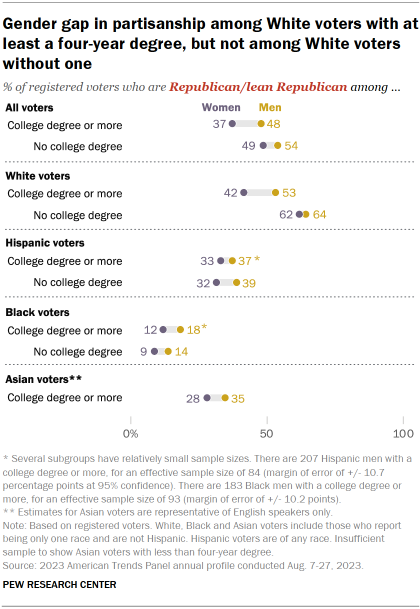
- Among White voters without a college degree, 64% of men and 62% of women say they identify as or lean toward the Republican Party (about a third of each associate with the Democrats).
- White men with a college degree also tilt Republican among voters, though to a lesser extent (53% are Republicans or lean Republican, 45% are Democrats or lean Democratic).
- In contrast, White women with a college degree are more Democratic than Republican by 15 percentage points (42% Republican or Republican leaning, 57% Democrat or lean Democrat).
Among Black and Hispanic voters, there are only modest differences in partisanship across the combination of gender and education. In both groups, there are no significant differences between men with and without college degrees, or between their women counterparts. (Because Asian American voters without a college degree are a small group, sample sizes do not allow comparing college and non-college Asian men and women.)
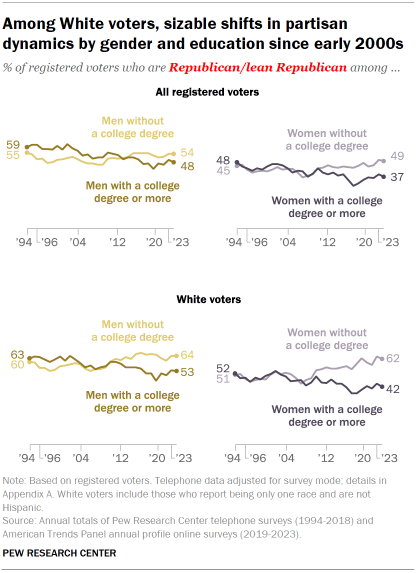
This dynamic has changed over time, as college-educated White men and women have grown more Democratic and those with less formal education have grown more Republican.
As recently as 15 years ago, there were sizable gender gaps in partisanship among both college and non-college White voters. In both cases, men were substantially more likely than women to associate with the Republican Party.
But, at that time, there was not a substantial difference in the partisanship of college and non-college White voters – for either women or men.
Today, there is no gender gap in partisanship among non-college White voters, while there is a gender gap among college graduate White voters. The difference in partisanship between White women voters who have a college degree and those who do not, in particular, is quite large.
By contrast, there is little variation in the partisanship of Black and Hispanic voters by these characteristics, and the relationship has varied less over time.
Sign up for our weekly newsletter
Fresh data delivery Saturday mornings

Sign up for The Briefing
Weekly updates on the world of news & information
- Education & Politics
- Election 2024
- Gender & Politics
- Political Parties
- Race, Ethnicity & Politics
- Religion & Politics
- Rural, Urban and Suburban Communities
- Voter Demographics
What’s It Like To Be a Teacher in America Today?
Republican gains in 2022 midterms driven mostly by turnout advantage, more americans disapprove than approve of colleges considering race, ethnicity in admissions decisions, partisan divides over k-12 education in 8 charts, school district mission statements highlight a partisan divide over diversity, equity and inclusion in k-12 education, most popular, report materials.
- Party Identification Detailed Tables, 1994-2023
1615 L St. NW, Suite 800 Washington, DC 20036 USA (+1) 202-419-4300 | Main (+1) 202-857-8562 | Fax (+1) 202-419-4372 | Media Inquiries
Research Topics
- Age & Generations
- Coronavirus (COVID-19)
- Economy & Work
- Family & Relationships
- Gender & LGBTQ
- Immigration & Migration
- International Affairs
- Internet & Technology
- Methodological Research
- News Habits & Media
- Non-U.S. Governments
- Other Topics
- Politics & Policy
- Race & Ethnicity
- Email Newsletters
ABOUT PEW RESEARCH CENTER Pew Research Center is a nonpartisan fact tank that informs the public about the issues, attitudes and trends shaping the world. It conducts public opinion polling, demographic research, media content analysis and other empirical social science research. Pew Research Center does not take policy positions. It is a subsidiary of The Pew Charitable Trusts .
Copyright 2024 Pew Research Center
Terms & Conditions
Privacy Policy
Cookie Settings
Reprints, Permissions & Use Policy
- Wednesday, April 24, 2024

© 2023 - Businessday NG. All Rights Reserved.

Wednesday 24 April 2024
- Leader comment
- Letters to the editor
- Sunday’s readings
- Faith features
- Book reviews
- Visual arts
- Performing arts
- Caption competition
- Out of the question
- 100 years ago

Chaplain speaks of fear on the Moscow metro
By ed beavan.

THE CHAPLAIN of St Andrew’s, Moscow, Canon Simon Stephens, said that the two suicide-bombings on the city’s metro on Monday had instilled a feeling of fear in the city.
It is reported that 39 people were killed, and at least 70 were injured, in the attacks, which Russian officials believe may have been carried out by Muslim militants from the north Caucasus.
Canon Stephens, who has been Chaplain of St Andrew’s since 1999, said that people were now nervous about travelling on the metro. “The biggest thing, of course, is that it instils fear. There are ten to 15 million people in the city who depend on the metro; traffic is horrific, and you either walk, or now dice with death on the metro.”
Armed police were patrolling the streets, he said. “It could impact on people attending Easter ceremonies. Many of my congregation travel from up to two hours away on the metro, and will now be wondering if someone is wearing an explosive belt on the train.”
Canon Stephens has received emails from people around the world offering their prayers, and has written to the Orthodox Patriarch of Moscow, Kirill I, to express his condolences. He said that the Archbishop of Canterbury and the Bishop of London, the Rt Revd Richard Chartres, had also sent letters of condolence to the Patriarch. The Office for the Dead was said in Christ the Saviour Cathedral on Tuesday.
Browse Church and Charity jobs on the Church Times jobsite
BNP governor faces removal
31 Mar 2010

New Primate glad to be anti-gay
Methodists are ‘yet alive’, don’t lock up children, says election campaign, inspectors: wycliffe hall could do more, other topics.

Top Comment

Landing zone needed for LLF
‘Compassionate orthodoxy’, not a divisive settlement, is required, says Christopher Landau
Job of the Week
London and home counties.
Anyone for mission?
Appointments
Development officer, west midlands.
Involved in patronage for more than a century, CPAS is now the largest patron in the Church of England
Missional Development Lead
Are you excited by the prospect of leading churches through change?
Chief Operating Officer
Following Christ in Alban’s footsteps
Find more jobs
Forthcoming Events
Church times/rscm:, festival of faith and music.
26 - 28 April 2024
See the full programme on the festival website.
Early bird tickets available
Intercultural Church for a Multicultural World
28 May 2024
A Church Times /Church House Publishing webinar
Tickets are FREE
Church Times/Modern Church:
A political faith.
Monday 3 June 2024
This panel will explore where Christians have come to in terms of political power and ask, where should we go next?
Online tickets available
Participating in Democracy
Monday 10 June 2024
This panel will explore the power of voting, and power beyond voting.
Green Church Awards
Closing date: 30 June 2024
R ead more details about the awards
Most Popular
Book review: colonialism: a moral reckoning by nigel biggar.

Angela Tilby: Soul Survivor proves point of institutional Church

Mike Pilavachi receives written warning after alleged misconduct

Leeds: a superdiocese comes of age

Matt Redman speaks on film about Pilavachi’s conduct

No further action over priest’s ‘ insensitive ’ vlog

Hymns minus the ‘awkward’ bits

Convent was run like a cult

Welcome to the Church Times

To explore the Church Times website fully, please sign in or subscribe.
Non-subscribers can read four articles for free each month. (You will need to register.)
Some results uranium dioxide powder structure investigation
- Processes of Obtaining and Properties of Powders
- Published: 28 June 2009
- Volume 50 , pages 281–285, ( 2009 )
Cite this article

- E. I. Andreev 1 ,
- K. V. Glavin 2 ,
- A. V. Ivanov 3 ,
- V. V. Malovik 3 ,
- V. V. Martynov 3 &
- V. S. Panov 2
116 Accesses
7 Citations
Explore all metrics
Features of the macrostructure and microstructure of uranium dioxide powders are considered. Assumptions are made on the mechanisms of the behavior of powders of various natures during pelletizing. Experimental data that reflect the effect of these powders on the quality of fuel pellets, which is evaluated by modern procedures, are presented. To investigate the structure of the powders, modern methods of electron microscopy, helium pycnometry, etc., are used. The presented results indicate the disadvantages of wet methods for obtaining the starting UO 2 powders by the ammonium diuranate (ADU) flow sheet because strong agglomerates and conglomerates, which complicate the process of pelletizing, are formed. The main directions of investigation that can lead to understanding the regularities of formation of the structure of starting UO 2 powders, which will allow one to control the process of their fabrication and stabilize the properties of powders and pellets, are emphasized.
This is a preview of subscription content, log in via an institution to check access.
Access this article
Price includes VAT (Russian Federation)
Instant access to the full article PDF.
Rent this article via DeepDyve
Institutional subscriptions
Similar content being viewed by others

Investigation of the Properties of Uranium-Molybdenum Pellet Fuel for VVER
L. A. Karpyuk, V. V. Novikov, … O. A. Bakhteev
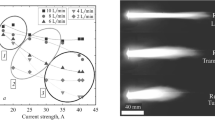
Investigation of the Influence of the Energy of Thermal Plasma on the Morphology and Phase Composition of Aluminosilicate Microspheres
V. V. Shekhovtsov
Evaluation of the Possibility of Fabricating Uranium-Molybdenum Fuel for VVER by Powder Metallurgy Methods
A. V. Lysikov, E. N. Mikheev, … D. S. Missorin
Patlazhan, S.A., Poristost’ i mikrostruktura sluchainykh upakovok tverdykh sharov raznykh razmerov (Porosity and Microstructure of Chaotic Packings of Solid Spheres of Different Sizes), Chernogolovka: IKhF RAN, 1993.
Google Scholar
Andreev, E.I., Bocharov, A.S., Ivanov, A.V., et al., Izv. Vyssh. Uchebn. Zaved., Tsvetn. Metall. , 2003, no. 1, p. 48.
Assmann, H., Dörr, W., and Peehs, M., “Control of HO 2 Microstructure by Oxidative Sintering,” J. Nucl. Mater. , 1986, vol. 140,issue 1, pp. 1–6.
Article ADS CAS Google Scholar
Download references
Author information
Authors and affiliations.
Elektrostal’ Polytechnical Institute (Branch), Moscow Institute of Steel and Alloys, ul. Pervomaiskaya 7, Elektrostal’, Moscow oblast, 144000, Russia
E. I. Andreev
Moscow Institute of Steel and Alloys (State Technical University), Leninskii pr. 4, Moscow, 119049, Russia
K. V. Glavin & V. S. Panov
JSC “Mashinostroitelny Zavod”, ul. K. Marksa 12, Elektrostal’, Moscow oblast, 144001, Russia
A. V. Ivanov, V. V. Malovik & V. V. Martynov
You can also search for this author in PubMed Google Scholar
Corresponding author
Correspondence to K. V. Glavin .
Additional information
Original Russian Text © E.I. Andreev, K.V. Glavin, A.V. Ivanov, V.V. Malovik, V.V. Martynov, V.S. Panov, 2009, published in Izvestiya VUZ. Poroshkovaya Metallurgiya i Funktsional’nye Pokrytiya, 2008, No. 4, pp. 19–24.
About this article
Andreev, E.I., Glavin, K.V., Ivanov, A.V. et al. Some results uranium dioxide powder structure investigation. Russ. J. Non-ferrous Metals 50 , 281–285 (2009). https://doi.org/10.3103/S1067821209030183
Download citation
Published : 28 June 2009
Issue Date : June 2009
DOI : https://doi.org/10.3103/S1067821209030183
Share this article
Anyone you share the following link with will be able to read this content:
Sorry, a shareable link is not currently available for this article.
Provided by the Springer Nature SharedIt content-sharing initiative
- nuclear fuel
- uranium dioxide
- uranium protoxide-oxide
- crystallite
- agglomerate
- conglomerate
- surface morphology
- ADU-ammonium diuranate
- Find a journal
- Publish with us
- Track your research
- Registration

*required fields
Log in to your account
Please, fill in the form below:
If you have forgotten your password, please click on the following link >>
Where Can I Find the Best Interior Design Education in Elektrostal, Russia?

Latest news

Small Space, Big Impact: Maximizing Plant Use in Compact Interiors

From Mountains to Seas: The Diversity of Earth's Landscapes and How to Incorporate Them in Our Homes

Top Home Interior Design Trends: Exploring Modern, Transitional, and Farmhouse Styles

Embracing the Past: Vintage Revival in Contemporary Interior Design

Seamless Transitions: Blurring the Lines Between Indoor and Outdoor Living

Through the Lens: The Art of Landscape Photography and the Beauty of Nature
See questions on:

Reimagining Urban Landscapes: Green Infrastructure and Smart City Initiatives

Green Spaces, Healthy Places: Exploring the Impact of Landscapes on Human Health

Landscapes of the Future: Sustainable Design and Conservation

Turning Your Garden into a Year-Round Wonderland

Top 5 Flooring Companies in Dubai: Best Flooring Dubai Supplier

10 Timeless Interior Design Trends That Never Go Out of Style

The Changing Face of Interior Design Throughout History

Downsizing Dilemma: Understanding the Trend of Shrinking Spaces

Designing for Brand Identity: Interior Design in Retail Spaces

Exploring the Charm of Shabby Chic Interior Design

Urban Maximalism

The Impact of Lighting Design on Office Productivity and Well-Being

Interior Design Trends in 2024 That You Should Follow

5 Steps to Financially Prepare for a Career in Interior Design
In the forum :, will wallpaper cover cracks, how do you learn autocad, should your interior match your exterior, how to design front yard landscaping, how to make kid room inviting, what is the best way to be successful in interior design, which online courses did you find most helpful, can you recommend any schools in valencia for studying interior design, what is traditional style interior design, what are the best dining table designs, what are my options for interior design studies in kinmen county, how many levels does home design have, where to find an interior decorator, what are the characteristics of traditional interior design, where to buy living room accessories, does wall art have to match, do i need curtains in my kitchen, are dining rooms outdated, how to do garden design drawings, are there any interior design programs offered in taranto, italy, can you have lighting in bedroom, what size mirror for living room, what are the advantages of interior decoration, how to choose a bedroom bench, can you recommend any colleges in taxco de alarcon that specialize in interior design, where to study interior design in australia, do all interior doors have to match, what is coastal interior design style, do you think online schools are a good option for aspiring interior designers, what defined 50's interior design style.

IMAGES
VIDEO
COMMENTS
Evidence-Based Behavior Management Strategies for Students With or at Risk of EBD: A Mega Review of the Literature. Benjamin S. Riden, PhD, ... Education and Treatment of Children, 32(3), 403-420. Crossref. Google Scholar *Bowman-Perrott L., Burke M. D., de Marin S., Zhang N., Davis H. (2015). A meta-analysis of single-case research on ...
behaviour management have the potential to produce significant impacts on disruptive behaviour. According to the Elton Report (1989, cited in the Office for Standards in Education, Children's Services and Skills 2005, section 65, p.15), it was estimated that in the United Kingdom 80 percent of disruptive behaviour was attributable
This article discusses how lessons from this theory can be applied in the classroom through behavior management practices that engage children more fully in school and produce long-term behavior improvements. What is self-determination theory? Self-determination theory is a conceptual framework for understanding human development.
The Key to Effective Classroom Management. A three-phase process helps build strong teacher-student bonds, which can reduce disruptive behavior. It's a daunting but all-too-common sight for many teachers: A classroom full of rowdy students who are unable to focus on the lesson. Classroom management techniques may get things back on track, but ...
Behaviour Management, The Tickell Review (2011) and Positive Psychology "Positive psychology" as advocated by Martin Seligman and others and the contention that "people can be re-crafted into goal achievers, able to control their emotions and harness all their positive energies in the service of their goals" (Miller, Citation 2008, p. 595) has become particularly influential in ...
In response to the call for inclusion, teachers are now managing challenging behavior in the general education classroom at increased rates. Co-teaching has been relied on by many teachers in order to create more inclusive classrooms, however, teachers continue to report feeling ill-prepared to manage student behavior effectively.
1. Manage your classroom. One thing most new teachers fear is challenging behaviour in the classroom. For some, it can even feel like the biggest hurdle to overcome in their early career. But there are positive ways to approach tricky challenges. "Understanding that classroom management is the macro.
It may be especially important that educators use highly effective behavior-management practices when teaching students with special needs, as this population is most at risk for academic failure, school drop-out, and expulsion (Bradley et al., 2008; Vaughn & Dammann, 2001). Effective behavior-management practices have been shown to increase ...
This refers to the act of planning, preparing and implementing strategies to manage the behaviour of students in your classroom. The following are proactive behaviour management strategies to support students: Creating a positive classroom culture: Creating a positive classroom culture is the first step to effective behaviour management.
Positive behavior strategies are evidence-based, proactive approaches to changing challenging student behavior. Some examples of positive behavior strategies are pre-correcting and prompting and nonverbal signals. There's a lot to think about when it comes to teaching. You plan and deliver lessons to cover the curriculum.
Functional analysis is a tool that allows educators to figure out the purpose or function of challenging behavior as well as the events that trigger and maintain it. Authored by: Barbara Kaiser, Judy Sklar Rasminsky. Members Only. Article. Young Children. September 1, 2022.
Many behavioral challenges in the classroom are driven by issues that have nothing to do with school. As appropriate, work with school counselors and administrators to assist the student with his ...
Journal of Behavioral Education is an international forum for original research on the application of behavioral principles and technology to education. Presents empirical research investigating best-practices and innovative methods addressing the needs of diverse learners and implementation. Places no restriction on the types of participants ...
Inclusive education for students with challenging behaviour: development of teachers' beliefs and ideas for adaptations through Lesson Study ... "Behaviour, Classroom Management and Student 'Control': Enacting Policy in the English Secondary School." International Studies in Sociology of Education 20 : 153-170. doi:10.1080/09620214. ...
In May, The University of Notre Dame Australia's Faculty of Education and Philosophy & Theology (FEPT) will host Tom Bennett OBE, the UK Education Department's independent behaviour advisor - and the founder and director of ResearchED - who will hold a series of lectures on this increasingly problematic issue.. Held online and in person in Fremantle, Sydney, and Melbourne, Bennett's ...
Abstract. This article presents concepts that the author believes to be essential for the effective management of student behavior. These behavior management concepts will help both veteran and ...
Gal, N. (2006) 'The role of Practicum supervisors in behaviour management education' Teaching and Teacher Education. 22, pp. 377-393. Attendance Policy. London: DfE. Bailey, R. (2001) 'Managing Behaviour', In Teaching Physical Education: A Handbook for Primary & Secondary School Teachers. London: Kogan Page. pp. 99-116.
A new report, released in time for global attention for Earth Day on April 22, highlights the impact of climate education on promoting behaviour change in the next generation.
Issues related to behavior management are not restricted to special education, because most educators report working with students who display challenging behaviors in their classrooms (Reinke et al., 2011; Westling, 2010). As such, it is imperative that all educators implement effective behavior-management practices.
By comparison, the Democratic Party has a 13-point advantage (55% vs. 42%) among those with a bachelor's degree or more formal education. This pattern is relatively recent. In fact, until about two decades ago the Republican Party fared better among college graduates and worse among those without a college degree.
In Africa, where markets are rapidly evolving, understanding and adapting to consumer behaviour can offer businesses a competitive edge. This article explores the relationship between consumer behaviour and supply chain planning and provides practical strategies for African companies to develop a customer-centric supply chain.
Two experiments studying the standard and modified VVER fuel fabricated at the Machine-Building Plant (in Elektrostal) and PWR fuel produced according to the typical specifications were performed on the HBWR research reactor (Halden, Norway) from 1995 to 2005. The objective of these experiments was to study the effect of the structural-technological parameters on the behavior of VVER fuel in ...
Microsoft is always excited to provide our education customers with solutions that simplify their IT admin experience so that they can focus on what matters most. In that spirit, Microsoft Intune and Microsoft Edge are thrilled to highlight the ability for schools to easily manage and customize the browser experience for students and staff with ...
THE CHAPLAIN of St Andrew's, Moscow, Canon Simon Stephens, said that the two suicide-bombings on the city's metro on Monday had instilled a feeling of fear in the city.
Journal of Management Education, 46(5), 853-887. Google Scholar. Brunt C. (2016). African managers' stories and cultural awareness: An exploratory classroom exercise. ... The influence of business schools on the ethical behavior of students: A study from Ghana. Africa Journal of Management, 6(1), 43-66. Google Scholar. Elmes M. B., Jiusto ...
Features of the macrostructure and microstructure of uranium dioxide powders are considered. Assumptions are made on the mechanisms of the behavior of powders of various natures during pelletizing. Experimental data that reflect the effect of these powders on the quality of fuel pellets, which is evaluated by modern procedures, are presented. To investigate the structure of the powders, modern ...
In this article, we will introduce you to the top university for interior design near Elektrostal, Russia. With its comprehensive curriculum, experienced faculty, and state-of-the-art facilities, this university offers the perfect platform for aspiring interior designers to hone their skills and achieve their career goals.